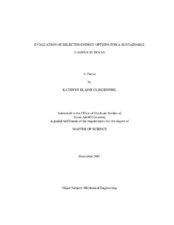| dc.description.abstract | This thesis examines ways to reduce energy consumption in university buildings.
Occupancy based controls and other advanced building technologies being studied at the
Intelligent Workplace (IW) at Carnegie Melon University were examined to see if they
could be applied in at Texas A&M International University (TAMIU). Additionally, a
sustainability assessment for the current TAMIU campus was performed with an
analysis of the potential for TAMIU to obtain LEED certification from the US Green
Building Council.
First, occupancy-based controls that would shut off lighting, utilize power
management features on computer equipment, and reduce airflow when a space is
unoccupied were examined. An estimated annual savings of $525 could be obtained in
the test office at Texas A&M by implementing these controls. If same controls were
applied to the proposed green building at TAMIU, approximately $203,422 could be
saved annually.
Secondly, advanced building technologies used at the IW were examined to see if
they are feasible in the new green building at TAMIU. Biodiesel cogeneration was
found to be economically infeasible as a main power supply using the loads calculated
for the building. A feasibility calculation for a radiant heating and cooling system with ventilation was performed and it was estimated that using one of these systems could
have potential at TAMIU if the building envelope is designed correctly. Displacement
ventilation could be implemented for research purposes in the test bed, but should not be
implemented on a broader basis until more is known about the performance of these
systems in hot and humid climates. Daylighting should be used in the new building
whenever its implementation will not significantly increase solar loads.
Thirdly, a sustainability assessment of the current TAMIU campus was
performed. Several good practices and areas for improvement were identified in nine
sustainability-related areas. The current TAMIU campus was examined to see what
scope of work would be required to achieve LEED certification from the US Green
Building Council. It was found that 39 credits, which is enough to achieve LEED
certification, are either achievable as-is, achievable with a policy change, or achievable
with a minor retrofit scope. | en |


